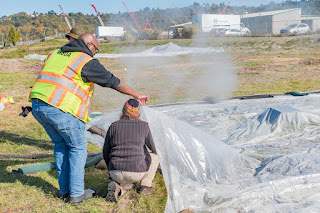Amber Betts WSDA Communications
 |
| Hops flower on the vine. |
With hop season right around the corner, we are preparing
for similar results with a limited workforce nationwide to do the work. So
we’re doing it again. Washington State Department of Agriculture (WSDA) is
preemptively increasing the pay for our hop samplers and graders to more than
$17 an hour. That’s nearly $2 more an hour than it has been in the past.
Every year we provide a service to the hop industry in
Washington state; “samplers” take a portion of the crop back to the lab in
Yakima where our “graders” get to work. After all is said and done, farmers are
left with a seed, leaf, and stem certificate that allows them to export their
product worldwide.
We are gearing up to hire more than 40 people to work about
six weeks from August to October. This is a busy job, full time, seven days a
week, with overtime. We are looking for graders to work in the lab and samplers
to go to the farms and warehouses to collect samples of the local hops.
As an “inspector” you’ll be part of the Plant Protection Division
of WSDA. The program grades hops for seed, leaf and stem content, and analyzes
hops for brewing value. The Yakima Valley produces over 70% of the U.S. hops
and 25% of the world’s hops. But first, we need the samples of the hops to
analyze. That’s where you come in.
Day in the life of a
sampler
As a sampler, you’ll travel to farms and warehouses,
maneuver bales of hops, collect the samples and label them correctly. You’ll
enter the information into WDSA software that we will train you how to use.
You’ll bring the samples back to the lab, where our graders will get to work.
This is the perfect chance to be part of the worldwide
industry. If sampling isn’t your speed, lab work might be for you.
Graders get the job done
Once the samples arrive, graders begin their work. You’ll
sort the samples, remove debris, record their weight, sift material into a
divider, and split samples between seeds and leaves/stems. The seed samples
will be taken to the oven, then the cones will be crushed into a powder leaving
behind remnants of the stems and seed. This will further be sorted, leaving
just the seed behind. Seed is something no farmer wants to see. It lowers the
grade of the hop.
 |
| Hops core samples taken for grading. |
To apply, visit our employment page.








